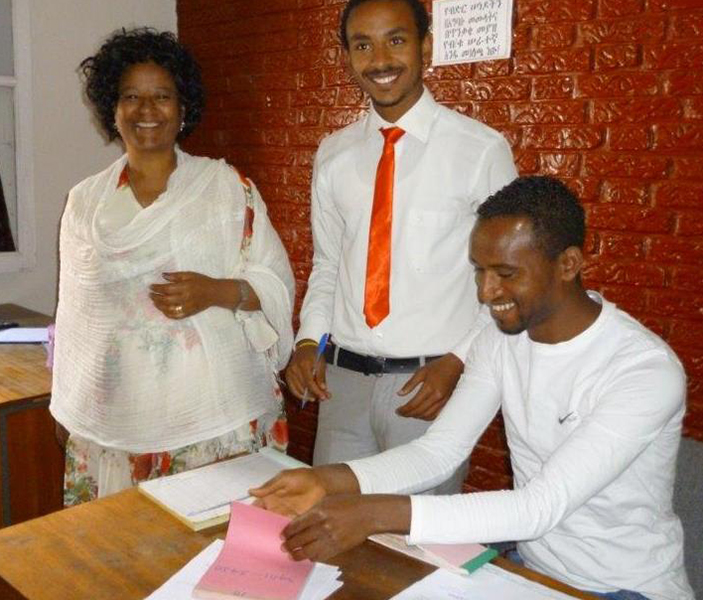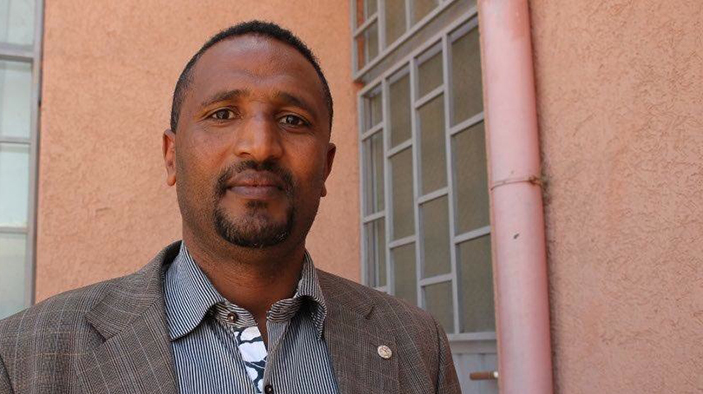DEVELOPMENTS
Serving the Missing Middle
Apr 24, 2015
Not long ago, Aynalem Gebryes had nowhere to turn to borrow money, despite having a steady income from fattening cattle, producing milk, growing potatoes, and selling directly to local hotels and restaurants.
This changed in January 2014, when the 56-year-old widowed mother of three from Addis Ababa became the first woman to receive a loan through the Women’s Entrepreneurship Development Programme (WEDP). Gebryes used her $7,500 loan to add two cows to her operation and build a government-backed biogas unit, from which she plans to sell any fuel she doesn’t use herself.
Gebryes was the first of many clients. In its first year, WEDP issued USD$21 million to 1,811 female small business operators—with no defaults. Borrowers represented the broad spectrum of Ethiopia’s small-business community, from grocery stores and construction companies to elementary schools and car-repair shops.

The program has met an urgent need in Ethiopia’s financial system. According to a 2010 survey by Dutch consultant Triodos Facet, 40 percent of small and medium-sized enterprises (SMEs) in Ethiopia identified inadequate access to credit as a serious impediment to growth. Women business owners, in particular, reported they needed loans for working capital or fixed assets such as equipment and vehicles. When asked why they could not access credit, the business owners cited a lack of collateral and said the loans available were too small and the interest rates too high.
Not much had changed by 2013 when the U.K. Department for International Development (DFID) started Private Enterprise Programme Ethiopia (PEPE), implemented by DAI, a project to help increase access to finance, support good quality jobs, and boost incomes for Ethiopia’s poor.
##Women and the Missing Middle##
The project launched WEDP to address the Ethiopian business community’s “missing middle”—women-owned businesses too big for a microloan and too small for a bank loan. While banks rarely loaned amounts less than ETB1 million (USD$50,000) and microfinance institutions (MFIs) primarily served the microbusiness market—such as oxen fatteners and street vendors of fruits, vegetables, dairy products, and cooked foods—some Ethiopian MFIs sensed an opportunity to scale up and reach this missing middle.
WEDP is assisting Ethiopian MFIs to fill that gap by providing a credit line targeting loans to urban, female-owned small businesses. The credit line of USD$42 million is funded by the World Bank and managed by the Development Bank of Ethiopia, with technical assistance to the on-lending development bank and to local MFIs funded by DFID and implemented by DAI.
(See the Q&A below with Wasasa CEO Amsalu Alemayehu.)
The issue of collateral has always been a challenge to businesswomen seeking credit in Ethiopia. When it came to larger loans, most MFIs, uncertain of how to appraise these applications, required applicants to put up personal residences as collateral, valued at a minimum of 200 percent of the loan amount. But many Ethiopian women did not hold title to the homes they lived in—title was in their husbands’ names in line with local custom. If WEDP were to facilitate these loans, collateral requirements would need to be adjusted.
Wasasa, a mid-sized, private MFI based outside Addis Ababa, was the first to begin lending using the WEDP credit line. With 28 branches and 20 rural offices, Wasasa had experimented with making small business loans up to $6,000, but the demand for such loans exceeded Wasasa’s available capital. The WEDP credit line and technical assistance—focused on lending to growth-oriented firms, design of loan products, and financial monitoring and reporting—enabled Wasasa to extend its reach.
Eight MFIs in Ethiopia are now lending to the missing middle using the WEDP credit line, operating in the main urban centers of Mekele, Bahir Dar, Adama, Hawassa, Addis Ababa, and Dire Dawa. Instead of relying on borrowers to put up their houses as collateral, the MFIs assess creditworthiness on the basis of cash flow analysis forms designed by DAI.
After one year of WEDP lending:
- Borrowers reported their earnings increased 24 percent on average, from ETB56,572 to ETB70,440;
- Collateral required to borrow decreased from 200 percent of the loan to 125 percent;
- Businesswomen projected creating three jobs on average because of their new access to capital; and
- Participating MFIs reported that 64 percent of their portfolios were first-time borrowers.
The PEPE project is scheduled to operate until March 2021, and we expect that WEDP loans will substantially assist and improve small-business activity in the locales it serves. But perhaps the most important result is already apparent: Women like Gebryes can now get the loans they are perfectly well placed to repay by virtue of their business acumen and ongoing business performance.

As WEDP enters its second year, we interviewed Wasasa CEO Amsalu Alemayehu (pictured) about his thoughts on the programme and what the future holds.
WEDP: Why was Wasasa initially interested in making larger loans?
Alemayehu: One of the major reasons was in regards to risk management. We wanted to diversify our portfolio, which at the time was more than 85 percent agricultural microloans. We also wanted to make these loans for improved liquidity management. Unlike our agricultural microloans, these individual loans to small businesses can be disbursed and repaid at any time in the year. Finally, we felt small business loans were important for employment creation.
WEDP: What has the demand been like for the Women’s Entrepreneurship Development Programme (WEDP) loans?
Alemayehu: The demand is there. We fully utilized our first disbursement from the WEDP credit line within one year and have successfully applied for a second disbursement. So far, we have disbursed about 122 WEDP loans, roughly ETB19.5 million ($963,000).
WEDP: How has WEDP worked to date?
Alemayehu: First, the credit line has been very helpful, especially given Wasasa’s modest size and the fact that we are not government affiliated. Now, we are trying to increase the accessibility to these loans by looking at different forms of collateral or guarantees, such as salary. In one of our WEDP branches we have repeat borrowers, and we are allowing them to borrow without collateral.
When it comes to the technical support, we received technical assistance in developing a tool for a cash-flow based appraisal of individual loans and are using this for other small business loans outside the WEDP programme. In addition to receiving training in the use of this tool, we are also getting support on savings, IT evaluation, risk management, and accounting, among other things. The technical assistance has been very helpful.
WEDP: What are Wasasa’s future plans for these larger, cash-flow based loans?
Alemayehu: So far, these larger loans represent about 12 percent of our total portfolio. We are planning to increase this at least to 20 to 25 percent, including both WEDP-type loans and our new value chain finance programme. Eventually, we would like to increase both these types of loans to 40 to 50 percent of our portfolio for greater diversification.